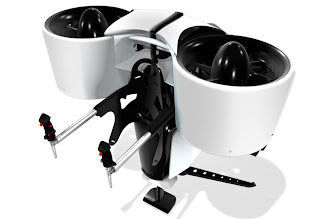Jet pack,
rocket belt,
rocket pack and similar names are used for various types of devices, usually worn on the back, that are propelled by jets of escaping gases (or in some cases liquid water) so as to allow a single user to fly.
The concept emerged from science fiction
in the 1920s and became popular in the 1960s as the technology became a
reality. The most common use of the jet pack has been in extra-vehicular activities for astronauts. Despite decades of advancement in the technology, the challenges of Earth's atmosphere, Earth's gravity, and the fact that the human body is not adapted to fly naturally remain an obstacle to its potential use in the military or as a means of personal transport.
Powerhouse Productions Rocketbelt
More commonly known as "The Rocketman", Powerhouse Productions, owned
and operated by Kinnie Gibson, is the first company to manufacture the
30 second flying Rocketbelt (June 1994) and to exclusively organize
Rocketbelt performances. Since 1983 Powerhouse Productions has performed
over show flights in over 40 countries such as the Carnival in Rio de
Janerio, Super Bowls, the Rose Parade, Daytona 500, and the Michael jackson Dangerous World Tour,
as well as many television shows including Walker Texas Ranger, The
Fall Guy and NCIS. Powerhouse Rocketbelt pilots include stuntman Kinnie
Gibson and Dan Schlund.
Turbojet pack
Packs with a turbojet engine are fueled with traditional kerosene. They have higher efficiency,
greater height and a duration of flight of many minutes, but they are
complex in construction and very expensive. Only one working model of
this pack was made; it underwent flight tests in the 1960s and at
present it no longer flies.
NASA's Manned Maneuvering Unit (MMU) (compressed gas powered)
In the 1980s, NASA demonstrated the Manned Maneuvering Unit (MMU), a rocket pack that allowed an astronaut
to function as his/her own spacecraft, but the system was retired
before the decade was over. The MMU is the only jet pack of practical
importance. Its operational area is outside a space station or spacecraft,
where an astronaut can limitedly move independently. The MMU's
propulsion was produced by high-pressure nitrogen gas discharged through
nozzles (of which the MMU has 24). The MMU was used after 1984 in three
Space Shuttle missions




No comments:
Post a Comment